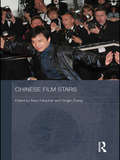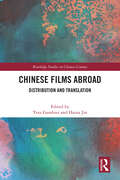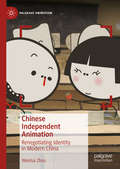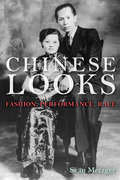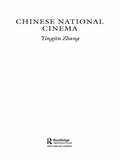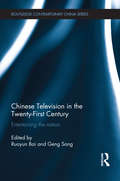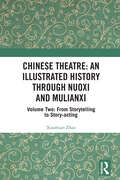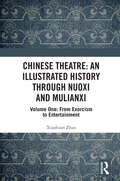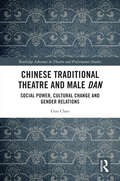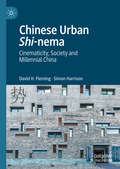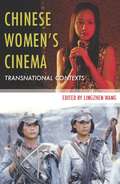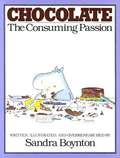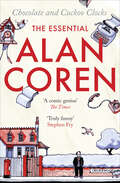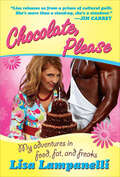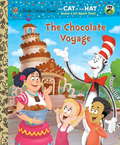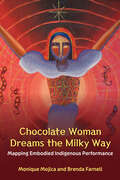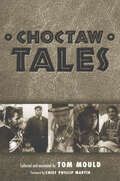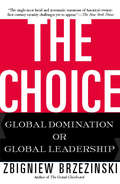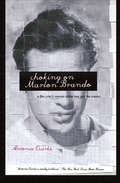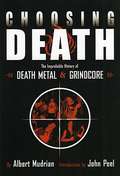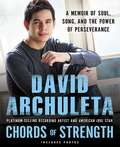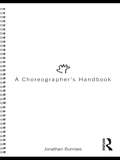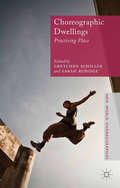- Table View
- List View
Chinese Film Stars (Routledge Contemporary China Series)
by Mary FarquharThis volume of original essays fills a significant research gap in Chinese film studies by offering an interdisciplinary, comparative examination of ethnic Chinese film stars from the silent period to the era of globalization. Whereas studies of stars and stardom have developed considerably in the West over the past two decades, there is no single book in English that critically addresses issues related to stars and stardom in Chinese culture. Chinese Film Stars offers exemplary readings of historically, geographically and aesthetically multifaceted star phenomena. An international line up of contributors test a variety of approaches in making sense of discourses of stars and stardom in China and the US, explore historical contexts in which Chinese film stars are constructed and transformed in relation to changing sociopolitical conditions, and consider issues of performance and identity specific to individual stars through chapter-by-chapter case studies. The essays explore a wide range of topics such as star performance, character type, media construction, political propaganda, online discourses, autobiographic narration, as well as issues of gender, genre, memory and identity. Including fifteen case studies of individual Chinese stars and illustrated with film stills throughout, this book is an essential read for students of Chinese film, media and cultural studies.
Chinese Films Abroad: Distribution and Translation (Routledge Studies in Chinese Cinema)
by Yves Gambier Haina JinThis book examines Chinese films made and shown abroad roughly between the 1920s and the 2020s, from the beginning of the international exchange of the Chinese national film industry to the emergence of the concept of soft power.The periodisation of Chinese cinema(s) does not necessarily match the political periods: on the one hand, the technical development of the film industry and the organisation of translation in China, and on the other hand, official relations with China and translation policies abroad impose different constraints on the circulation of Chinese films. This volume deals with the distribution and translation of films from mainland China, Taiwan, Hong Kong, and the Chinese diaspora. To this end, the contributors address various issues related to the circulation and distribution of Chinese films, including co- productions, agents of exchange, and modes of translation. The approach is a mixture of socio- cultural and translational methods. The data collected provides, for the first time, a quantitative overview of the circulation of Chinese films in a dozen foreign countries.The book will greatly interest scholars and students of Chinese cinema, translation studies, and China studies.
Chinese Independent Animation: Renegotiating Identity in Modern China (Palgrave Animation)
by Wenhai ZhouThis study of ‘independent’ animation opens up a quietly subversive and vibrant dimension of contemporary Chinese culture which, hitherto, has not received as much attention as dissident art or political activism. Scholarly interest in Chinese animation has increased over the last decade, with attention paid to the conventional media circle of production, distribution and consumption. The ‘independent’ sector has been largely ignored however, until now. By focusing on distinctive independent artists like Pisan and Lei Lei, and situating their work within the present day media ecology, the author examines the relationship between the genre and the sociocultural transformation of contemporary China. Animation, the author argues, has a special significance, as the nature of the animation text is itself multilayered and given to multiple interpretations and avenues of engagement. Through an examination of the affordances of this ‘independent’ media entity, the author explores how this multifaceted cultural form reveals ambiguities that parallel contradictions in art and society. In so doing, independent animation provides a convenient ‘mirror’ for examining how recent social upheavals have been negotiated, and how certain practitioners have found effective ways for discussing the post-Socialist reality within the current political configuration.
Chinese Looks
by Sean MetzgerFrom yellow-face performance in the 19th century to Jackie Chan in the 21st, Chinese Looks examines articles of clothing and modes of adornment as a window on how American views of China have changed in the past 150 years. Sean Metzger provides a cultural history of three iconic objects in theatrical and cinematic performance: the queue, or man's hair braid; the woman's suit known as the qipao; and the Mao suit. Each object emerges at a pivotal moment in US-China relations, indexing shifts in the balance of power between the two nations. Metzger shows how aesthetics, gender, politics, economics, and race are interwoven and argues that close examination of particular forms of dress can help us think anew about gender and modernity.
Chinese National Cinema (National Cinemas #20)
by Yingjin ZhangThis introduction to Chinese national cinema covers three 'Chinas': mainland China, Hong Kong and Taiwan. Historical and comparative perspectives bring out the parallel developments in these three Chinas, while critical analysis explores thematic and stylistic changes over time. As well as exploring artistic achievements and ideological debates, Yingjin Zhang examines how - despite the pressures placed on the industry from state control and rigid censorship - Chinese national cinema remains incapable of projecting a single unified picture, but rather portrays many different Chinas.
Chinese Television in the Twenty-First Century: Entertaining the Nation (Routledge Contemporary China Series)
by Ruoyun Bai Geng SongThe past two decades witnessed the rise of television entertainment in China. Although television networks are still state-owned and Party-controlled in China, the ideological landscape of television programs has become increasingly diverse and even paradoxical, simultaneously subservient and defiant, nationalistic and cosmopolitan, moralistic and fun-loving, extravagant and mundane. Studying Chinese television as a key node in the network of power relationships, therefore, provides us with a unique opportunity to understand the tension-fraught and , paradox-permeated conditions of Chinese post-socialism. This book argues for a serious engagement with television entertainment. rethinking, It addresses the following questions. How is entertainment television politically and culturally significant in the Chinese context? How have political, industrial, and technological changes in the 2000s affected the way Chinese television relates to the state and society? How can we think of media regulation and censorship without perpetuating the myth of a self-serving authoritarian regime vs. a subdued cultural workforce? What do popular televisual texts tell us about the unsettled and reconfigured relations between commercial television and the state? The book presents a number of studies of popular television programs that are sensitive to the changing production and regulatory contexts for Chinese television in the twenty-first century. As an interdisciplinary study of the television industry, this book covers a number of important issues in China today, such as censorship, nationalism, consumerism, social justice, and the central and local authorities. As such, it will appeal to a broad audience including students and scholars of Chinese culture and society, media studies, television studies, and cultural studies.
Chinese Theatre: Volume Two: From Storytelling to Story-acting
by Xiaohuan ZhaoChinese Theatre: An Illustrated History Through Nuoxi and Mulianxi is the first book in any language entirely devoted to a historical inquiry into Chinese theatre through Nuoxi and Mulianxi, the two most representative and predominant forms of Chinese temple theatre. Volume Two is a continuation of the historical inquiry into Chinese theatre with focus shifted from Mulian storytelling to Mulian story-acting. Thus, this volume traces the historical trajectory of xiqu from Northern dramas to Southern dramas and from elite court theatre to mass regional theatre with pivotal forms and functions of Mulianxi examined, explicated and illustrated in association with the development of corresponding genres of xiqu. In so doing, every aspect of Mulianxi is considered not in the margins of xiqu but in and of itself. While this volume is primarily concerned with Mulianxi, references are also made to other forms of Chinese performing arts and temple theatre, Nuoxi in particular, as Mulianxi has been performed since the twelfth century as, or in company with, Nuoxi, to cleanse the community of evil spirits and epidemic diseases. This is an interdisciplinary book project that is aimed to help researchers and students of theatre history understand the ritual origins of Chinese theatre and the dynamic relationships among myth, ritual, religion and theatre.
Chinese Theatre: Volume One: From Exorcism to Entertainment
by Xioahuan ZhaoChinese Theatre: An Illustrated History Through Nuoxi and Mulianxi is the first book in any language entirely devoted to a historical inquiry into Chinese theatre through Nuoxi and Mulianxi, the two most representative and predominant forms of Chinese temple theatre. With a view to evaluating the role of temple theatre in the development of xiqu or traditional Chinese theatre and drama from myth to ritual to ritual drama to drama, Volume One provides a panoramic perspective that allows every aspect of Nuoxi to be considered, not in the margins of xiqu but in and of itself. Thus, this volume traces xiqu history from its shamanic roots in exorcism rituals of Nuo to various forms of ritual and theatrical performance presented at temple fairs, during community and calendrical festivals or for ceremonial functions over the course of imperial history, and into the twenty-first century, followed by an exploration of the scriptural origins and oral traditions of Mulianxi, with pivotal forms and functions of Nuoxi and Mulian storytelling, examined, explicated and illustrated in association with the development of corresponding genres of Chines performance literature and performing arts. This is an interdisciplinary book project that is aimed to help researchers and students of theatre history understand the ritual origins of Chinese theatre and the dynamic relationships among myth, ritual, religion, and theatre.
Chinese Traditional Theatre and Male Dan: Social Power, Cultural Change and Gender Relations (Routledge Advances in Theatre & Performance Studies)
by Guo ChaoThis book examines male dan, a male actor who performs female roles in Chinese theatre. Through the rise, fall and tenuous survival of male dan in Chinese history, Guo Chao reflects the transformations in the social zeitgeist in China, especially the politics of gender and sexuality. The breadth of this study reflects a diversified set of sources, ranging from classical to contemporary texts (texts of jingju plays, memoirs, collections of notation books) and other commentaries and critical evaluations of dan actors (in both English and Chinese languages), to video and audio materials, films, and personal interviews. This book will be of great interest to students and scholars of East Asian/Chinese studies across the fields of theatre, history, culture, and literature.
Chinese Urban Shi-nema: Cinematicity, Society and Millennial China
by David H. Fleming Simon HarrisonThis book dives into the mise-en-scène of contemporary China to explore the “becoming cinema” of Chinese cities, societies, and subjectivities. Set in the wake of China’s radical and rapid period of urbanization and infrastructural transformation, and situating itself in the processual city of Ningbo, the book combines empirical, ficto-critical, and philosophical methods to generate a dynamic account of everyday life as new forms of consumer culture bed in. Harnessing a Realist approach that allows for different scales of analysis, the book zooms in on five architectural assemblages including: surreal real estate showrooms; a fragmented history museum; China’s “first and best” Sino-foreign university; a new “Old town”; and weird gamified “any-now(here)-spaces.” Together these modern arrangements and machines for living cast light upon the broader picture sweeping up greater China.
Chinese Women’s Cinema: Transnational Contexts (Film and Culture Series)
by Lingzhen WangThe first of its kind in English, this collection explores twenty one well established and lesser known female filmmakers from mainland China, Hong Kong, Taiwan, and the Chinese diaspora. Sixteen scholars illuminate these filmmakers' negotiations of local and global politics, cinematic representation, and issues of gender and sexuality, covering works from the 1920s to the present. Writing from the disciplines of Asian, women's, film, and auteur studies, contributors reclaim the work of Esther Eng, Tang Shu Shuen, Dong Kena, and Sylvia Chang, among others, who have transformed Chinese cinematic modernity.Chinese Women's Cinema is a unique, transcultural, interdisciplinary conversation on authorship, feminist cinema, transnational gender, and cinematic agency and representation. Lingzhen Wang's comprehensive introduction recounts the history and limitations of established feminist film theory, particularly its relationship with female cinematic authorship and agency. She also reviews critiques of classical feminist film theory, along with recent developments in feminist practice, altogether remapping feminist film discourse within transnational and interdisciplinary contexts. Wang's subsequent redefinition of women's cinema, and brief history of women's cinematic practices in modern China, encourage the reader to reposition gender and cinema within a transnational feminist configuration, such that power and knowledge are reexamined among and across cultures and nation-states.
Chinese Women's Cinema: Transnational Contexts
by Lingzhen WangThe first of its kind in English, this collection covers twenty one well established and lesser known female filmmakers from mainland China, Hong Kong, Taiwan, and the Chinese diaspora. Sixteen scholars illuminate these filmmakers' negotiations of local and global politics, cinematic representation, and issues of gender and sexuality, covering works from the 1920s to the present. Writing from the disciplines of film, Asian, women's, and auteur studies, contributors reclaim the work of Esther Eng, Tang Shu Shuen, Dong Kena, and Sylvia Chang, among others who have transformed Chinese cinematic modernity. This collection creates a unique transcultural, interdisciplinary conversation on authorship, feminist cinema, transnational gender, and cinematic agency and representation. Lingzhen Wang's comprehensive introduction recounts the history and limitations of established feminist film theory, particularly its relationship with female cinematic authorship and agency. She also reviews critiques of classical feminist film theory, along with recent developments in feminist practice, ultimately remapping feminist film discourse within transnational and interdisciplinary contexts. Wang's subsequent redefinition of women's cinema and brief history of women's cinematic practices in modern China encourage the reader to reposition gender and cinema within a transnational feminist configuration, especially in such a way that power and knowledge are reexamined among and across cultures and nation-states.
Chocolate: The Consuming Passion
by Sandra BoyntonA New York Times bestseller with over a half-million copies in print, CHOCOLATE continues to delight chocoholics everywhere. Packed with Boynton's famous hippos, bunnies, pigs, and other animals, this gift-perfect book is a whimsical commentary on the individual's relationship to chocolate, its varieties, and its sources. From the several sorts of chocolate connoisseur-including the gourmoo, who eats only milk chocolate-to the several shapes of chocolate itself (bunny, kiss, glove compartment bar), Boynton's apologia for chocolate misses nothing. Myths are debunked: chocolate is not fattening, she argues, especially when the caloric expenditure of carrying it home from the store and hiding it from company is factored in. Directions are supplied: to remove stains, lick them. Plus, how to grow chocolate at home, a foolproof method for determining if chocolate is in season (does the name of the month contain the letter A, E, or U?), and a recipe for Hippo Pot de Mousse. "Fourteen out of ten people like chocolate," says the artist. This is the only guide for people who like chocolate the way they like to breathe. Vanilla people, keep out. Selection of the Literary Guild.
Chocolate and Cuckoo Clocks: The Essential Alan Coren
by Alan CorenA hilarious anthology of comic treasures written by Britain&’s &“comic genius&”—the former editor of Punch and beloved regular on BBC&’s Radio 4 (The Times). Alan Coren was one of contemporary Britain&’s most prolific humorists. Over his forty-year career, Coren wrote comic and satirical pieces for The New Yorker, The Times, Observer, Tatler, Daily Mail, Mail on Sunday, and Punch, and published more than twenty books including The Sanity Inspector, Golfing for Cats and The Collected Bulletins of Idi Amin. This anthology draws together the best of Coren&’s previously published material as well as never-before-published autobiographical material. In these pages, you will find the queen at a loose end playing I-Spy, QPR fans arguing at the cheese counter, prank phone calls to Mao Tse-Tung, the Roman tax collector Glutinus Sinus dealing with the mud-caked Britons, Gatling guns, an Italian driving school, herons, hearing aids, hosepipe bans, talking parrots . . . Welcome to the wonderful world of the late, great Alan Coren! &“Truly funny.&” —Stephen Fry, actor, producer, director, and author of The Hippopotamus
Chocolate, Please: My Adventures in Food, Fat, and Freaks
by Lisa LampanelliAn inside look at the life of Comedy's Lovable Queen of Mean, Lisa Lampanelli, as she dishes on everything from relationships, food, and fat to why once you go black, you never go back In her jaw-droppingly hilarious and politically incorrect memoir, Lisa reveals all—including the dysfunctional childhood that made her the insult comic she is today, the subject for which she's best known (black men, black men, and more black men), and her hilarious struggles with her addiction to food and hot guys. By telling her story in her very real, very candid, very open way, Lisa shows her audience that it's okay to be yourself, even if it's just one rehab stint at a time. Lisa also takes readers behind the scenes at the roasts that have marked her comedy career and launched her into the comedy elite, and reveals the important "firsts" in her career, including her first time on her hero's program, The Howard Stern Show.Chocolate, Please is a side-splittingly funny portrait of the woman behind the award-winning insult comedy.
The Chocolate Voyage (Little Golden Book)
by Dave Aikins Tish RabeWhen the Cat in the Hat eats Nick's last piece of chocolate, the gang visits the Forest of Coco-a-licious to learn to make their own. There they discover that chocolate is made from cocoa beans which grow on trees--and that the raw beans actually taste pretty awful! Undeterred, the gang help harvest, dry, and roast the beans, separate the cocoa butter and liquids, and cook the mixture with sugar to make the sweet confection we all know and love. A perfectly tasty read for any time of the year, The Chocolate Voyage is ideal for Christmas, Valentine's Day, Easter, Halloween--any time chocolate is on the menu! Fans of the hit PBS Kids' television show The Cat in the Hat Know a Lot About That! will gobble this one up!
Chocolate Woman Dreams the Milky Way: Mapping Embodied Indigenous Performance (Theater: Theory/Text/Performance)
by Monique Mojica Brenda FarnellThis volume documents the creation of Chocolate Woman Dreams the Milky Way, a play written and performed by Monique Mojica with collaborators from diverse disciplines. Inspired by the pictographic writing and mola textiles of the Guna, an indigenous people of Panama and Colombia, the book explores Mojica’s unique approach to the performance process. Her method activates an Indigenous theatrical process that privileges the body in contrast to Western theater’s privileging of the written text, and rethinks the role of land, body, and movement, as well as dramatic story-structure and performance style. Co-authored with anthropologist Brenda Farnell, the book challenges the divide between artist and scholar, and addresses the many levels of cultural, disciplinary, and linguistic translations required to achieve this. Placing the complex intellect inherent to Indigenous Knowledges at its center, the book engages Indigenous performance theory, and concepts that link body, land, and story, such as terra nullius/corpus nullius, mapping, pattern literacy, land literacy, and movement literacy. Enhanced by contributions from other artists and scholars, the book challenges Eurocentric ideologies about what counts as “performance” and what is required from an “audience,” as well as long-standing body-mind dualisms.
Choctaw Tales
by Tom MouldIncluding stories from the 1700s to today, Choctaw Tales showcases the mythic, the legendary and supernatural, the prophecies and histories, the animal fables and jokes that make up the rich and lively Choctaw storytelling tradition. The stories display intelligence, artistry, and creativity as Choctaw narrators, past and present, express and struggle with beliefs, values, humor, and life experiences. Photographs of the storytellers complement the text. For sixteen tales, the Choctaw-language version appears in addition to the English translation. Many of these stories, passed down through generations, address the Choctaw sense of isolation and tension as storytellers confront eternal, historical, and personal questions about the world and its inhabitants. Choctaw Tales, the first book to collect these stories, creates a comprehensive gathering of oral traditions from the Mississippi Band of Choctaw Indians. Each story brings to life the complex and colorful world of the Choctaw tribe and its legend and lore. The shukha anumpa include tall tales, jokes, and stories of rabbits, turtles, and bears. The stories of the elders are populated by spirits that bring warnings and messages to the people. These tales provide a spectrum of legend and a glimpse of a vibrant, thriving legacy.
The Choice: Global Domination or Global Leadership
by Zbigniew BrzezinskiAmerican power and a pervasive globalization are the central realities of today's world, and the source of its thorniest dilemmas. Yet while America's unprecedented might should be the source of global security, Americans today feel less secure than ever. Globalization promotes American dominance even as it breeds anti-American resentment. In The Choice, former National Security Advisor Zbigniew Brzezinski addresses the historic choice facing America at this very moment: Will it strive to dominate the world, or lead it? Reminding us that American dominance should not be confused with omnipotence, Brzezinski shows how America's well-being and the world's are entwined, and that America must find a way to be both guarantor of global security and promoter of the global common good. "When it comes to what might be called the 'philosophy' of foreign policy-the relationship of U. S. power and policy to broader historical and cultural trends-no statesman of Brzezinski's generation is in his league. . . . A tour d'horizon of U. S. foreign policy [that] discusses the inevitable contradictions and tensions that enmesh a democratic society that is also a global hegemon, criticizes the Bush administration, and articulates his own vision of the way forward-all in a little over 200 pages. Even those who do not accept Brzezinski's critique of the Bush administration will admire the sagacity of his views; for Democrats attempting to assemble a serious and thoughtful alternative to Bush's foreign policy, The Choice is indispensable. "-Walter Russell Mead, Foreign Affairs
Choking on Marlon Brando: A Film Critic's Memoir About Love and the Movies
by Antonia QuirkeIn this witty and bittersweet memoir, the film critic shares her misadventures as a lover of film stars who seeks movie romance in the real world. Antonia Quirke was ten years old when she first saw Marlon Brando in A Streetcar Named Desire. It was the first film she ever saw, and her reaction was so intense that her parents called an ambulance. So began her lifelong love of movies—an obsession that has brought as much drama and comedy to her actual life as she sees on screen. In Choking on Marlon Brando, Quirke offers a window into her life as a film critic, her unabashed infatuation with male screen idols, and her many real-life romances that never quite make the cut. We learn of her personal ad seeking Tom Cruise, and her bungled interview with Jeff Bridges; the writer boyfriend who never brushed his teeth, and the actor boyfriend whose family showed up nude to a party. Along the way, Quirke provides witty insight into the nature of celebrity, fandom, the movies we all love, and how different they are from reality. “Fans of snappy writing, movie actors and dead-end romance will find Quirke’s book a treat.” —Publishers Weekly
Choosing Death: The Improbable History of Death Metal and Grindcore
by Albert MudrianThis exciting history, featuring an introduction by famed DJ John Peel, tells the two-decade-long history of grindcore and death metal through the eyes and ringing ears of the artists, producers, and label owners who propelled them.
Chords of Strength: A Memoir of Soul, Song, and the Power of Perseverance
by David ArchuletaSinging sensation and American Idol favorite David Archuleta tells his inspiring personal story. A runner-up on American Idol and successful music artist, David Archuleta was named one of the "breakout stars of 2008" by Forbes magazine and landed the number two spot on the Billboard charts. In Chords of Strength, David shares his unexpected and inspiring journey, including how he overcame vocal cord paralysis to achieve his dream of being a singer. He reveals insecurities he felt about his voice - before he realized that he loved the way singing made him feel more than he disliked the way he sounded. In this personal memoir, David opens up about the strength he draws from his unshakable faith and unyielding family. He pays tribute to those who continue to inspire him and through their example help him believe in himself, his talent, and his abilities. Intimate and uplifting, Chords of Strength allows a unique glimpse of the man behind the music and offers hope to anyone with a passion and a dream.
A Choreographer's Handbook
by Jonathan BurrowsOn choreography: "Choreography is a negotiation with the patterns your body is thinking" On rules: "Try breaking the rules on a need to break the rules basis" A Choreographer’s Handbook invites the reader to investigate how and why to make a dance performance. In an inspiring and unusually empowering sequence of stories, ideas and paradoxes, internationally renowned dancer, choreographer and teacher Jonathan Burrows explains how it’s possible to navigate a course through this complex process. It is a stunning reflection on a personal practice and professional journey, and draws upon five years’ of workshop discussions, led by Burrows. Burrows’ open and honest prose gives the reader access to a range of exercises, meditations, principles and ideas on choreography that allow artists and dance-makers to find their own aesthetic process. It is a book for anyone interested in making performance, at whatever level and in whichever style.
Choreographic Dwellings: Practising Place (New World Choreographies)
by G. Schiller S. RubidgeChoreographic Dwellings: Practising Place offers new readings of the kinaesthetic experiences of site-specific and nomadic performance, parkour, installation and walking practices. It extends the remit of the choreographic by reframing the kinaesthetic qualities of place as action.
Choreographic Dwellings
by Gretchen Schiller Sarah RubidgeChoreographic Dwellings explores performance practices that extend the remit of the choreographic. Covering walking practices, site-specific and nomadic performance that explore the movement potentials of everyday environments, parkour and art installation, it offers a reframing of the topologically kinaesthetic experience of the choreographic.
